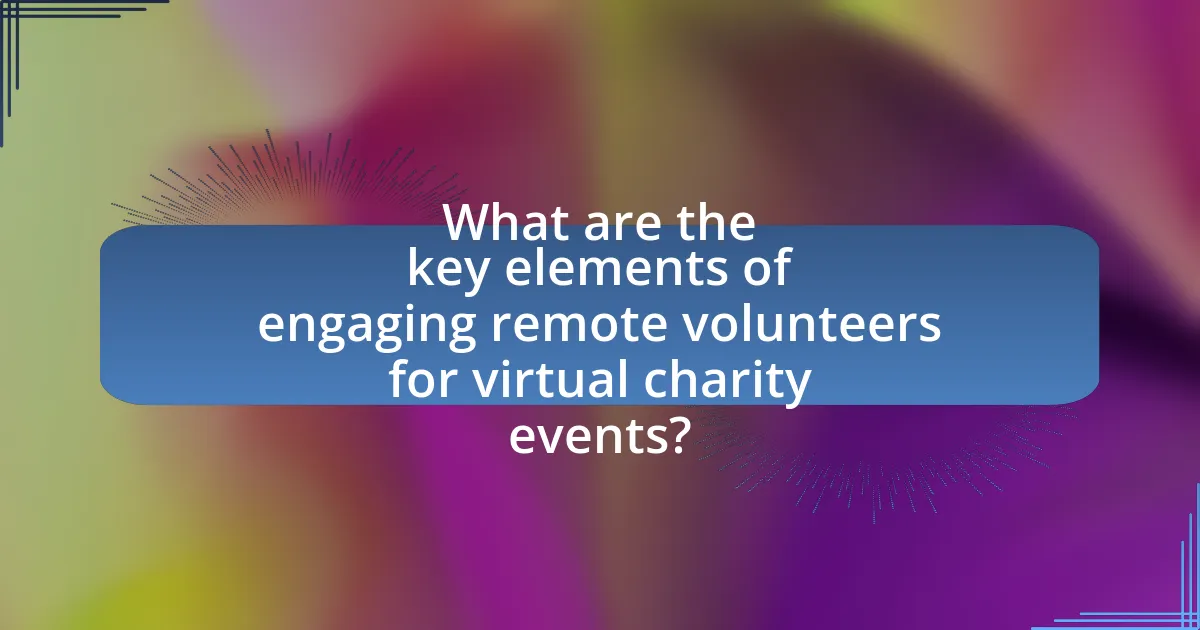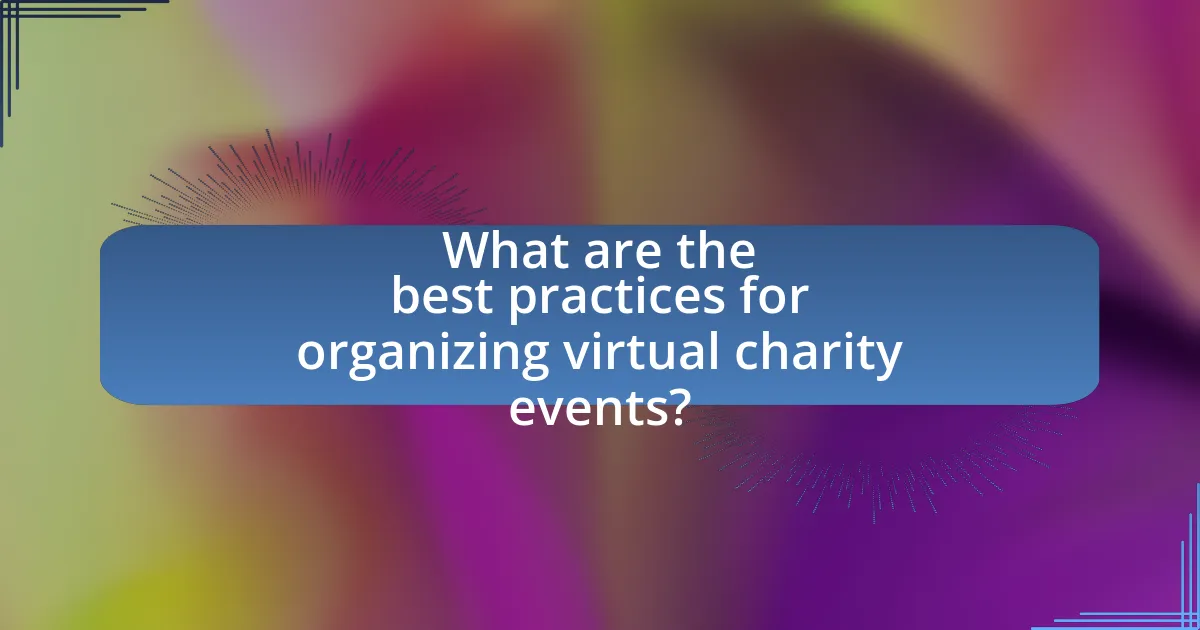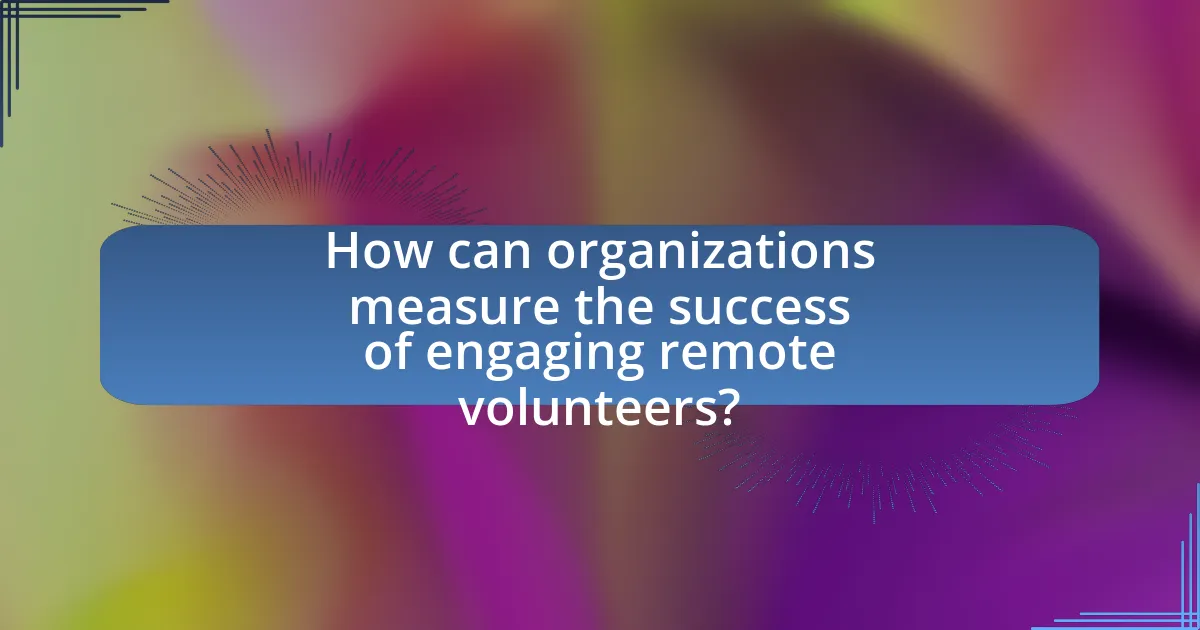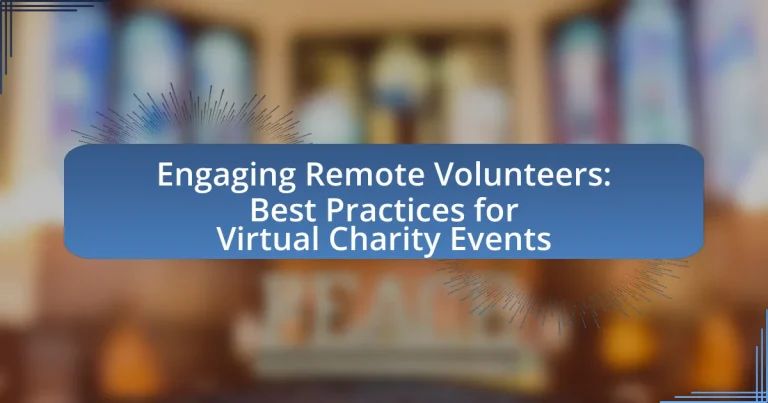The article focuses on best practices for engaging remote volunteers in virtual charity events. It outlines key elements such as clear communication, meaningful roles, recognition, and community building, which are essential for enhancing volunteer satisfaction and retention. The article also discusses effective recruitment strategies, the importance of utilizing social media and technology, and methods for creating a sense of community among volunteers. Additionally, it addresses challenges like communication barriers and volunteer burnout, providing practical tips for successful event organization and volunteer management. Overall, the content serves as a comprehensive guide for organizations aiming to optimize their virtual volunteer engagement efforts.

What are the key elements of engaging remote volunteers for virtual charity events?
The key elements of engaging remote volunteers for virtual charity events include clear communication, meaningful roles, recognition, and community building. Clear communication ensures that volunteers understand their tasks and expectations, which enhances their effectiveness and satisfaction. Meaningful roles allow volunteers to contribute in ways that align with their skills and interests, increasing their investment in the event. Recognition of volunteers’ efforts fosters a sense of appreciation and belonging, which is crucial for motivation. Community building through interactive platforms and social engagement helps create connections among volunteers, making them feel part of a larger mission. These elements are supported by studies indicating that effective volunteer management leads to higher retention rates and improved event outcomes.
How can organizations effectively recruit remote volunteers?
Organizations can effectively recruit remote volunteers by leveraging online platforms and social media to reach a broader audience. Utilizing websites dedicated to volunteer opportunities, such as VolunteerMatch or Idealist, allows organizations to post specific roles and attract individuals interested in remote work. Additionally, promoting volunteer opportunities through social media channels can enhance visibility and engagement, as studies show that 79% of volunteers are motivated by social media outreach. Clear communication of the organization’s mission and the impact of volunteer work is crucial, as potential volunteers are more likely to engage when they understand how their contributions will make a difference.
What platforms are best for reaching potential remote volunteers?
The best platforms for reaching potential remote volunteers include social media networks like Facebook, LinkedIn, and Twitter, as well as volunteer-specific websites such as VolunteerMatch and Idealist. These platforms have large user bases and targeted features that facilitate connections between organizations and individuals seeking volunteer opportunities. For instance, Facebook has over 2.8 billion monthly active users, making it an effective channel for outreach and engagement. LinkedIn allows organizations to connect with professionals who may be interested in volunteering their skills, while VolunteerMatch and Idealist specifically cater to those looking for volunteer roles, enhancing the likelihood of finding suitable candidates.
How can organizations leverage social media for volunteer recruitment?
Organizations can leverage social media for volunteer recruitment by creating targeted campaigns that highlight their mission and the impact of volunteering. By utilizing platforms like Facebook, Instagram, and Twitter, organizations can reach a wider audience, engage potential volunteers through compelling content, and share success stories that resonate with their community. Research indicates that 79% of people say user-generated content highly impacts their purchasing decisions, which can be translated to volunteer recruitment as well, showcasing the value of authentic testimonials from current volunteers. Additionally, organizations can use social media advertising to target specific demographics, ensuring that their recruitment efforts are directed towards individuals who are most likely to engage with their cause.
What strategies can enhance volunteer engagement during virtual events?
To enhance volunteer engagement during virtual events, organizations should implement interactive elements such as polls, breakout rooms, and Q&A sessions. These strategies foster participation and create a sense of community among volunteers. Research indicates that interactive formats can increase engagement by up to 70%, as they encourage active involvement rather than passive observation. Additionally, providing clear roles and responsibilities for volunteers during the event can enhance their sense of purpose and commitment, leading to higher satisfaction and retention rates.
How can organizations create a sense of community among remote volunteers?
Organizations can create a sense of community among remote volunteers by implementing regular virtual meetings and collaborative projects. These interactions foster relationships and enhance engagement, as evidenced by a study from the Stanford Social Innovation Review, which found that consistent communication increases volunteer retention rates by 50%. Additionally, utilizing online platforms for social interaction, such as forums or social media groups, allows volunteers to share experiences and support one another, further strengthening community ties.
What role does communication play in engaging remote volunteers?
Communication is essential for engaging remote volunteers as it fosters connection, clarity, and motivation. Effective communication strategies, such as regular updates, feedback loops, and virtual meetings, help remote volunteers feel included and valued, which enhances their commitment to the cause. Research indicates that organizations with strong communication practices report higher volunteer retention rates, with a study by the Corporation for National and Community Service showing that effective communication increases volunteer satisfaction and engagement by up to 50%. This demonstrates that clear and consistent communication is a critical factor in successfully engaging remote volunteers in virtual charity events.

What are the best practices for organizing virtual charity events?
The best practices for organizing virtual charity events include clear goal setting, effective promotion, engaging content, and seamless technology use. Establishing specific fundraising goals helps to focus efforts and measure success. Promoting the event through social media, email campaigns, and partnerships increases visibility and participation; for instance, a study by Nonprofit Tech for Good found that 73% of nonprofits reported social media as their most effective fundraising tool. Creating engaging content, such as interactive activities or guest speakers, keeps participants interested and encourages donations. Finally, ensuring reliable technology, such as using platforms like Zoom or Facebook Live, minimizes technical issues and enhances the overall experience for attendees.
How can organizations ensure a smooth virtual event experience?
Organizations can ensure a smooth virtual event experience by implementing robust technology solutions and thorough planning. Utilizing reliable platforms with high bandwidth capabilities minimizes technical disruptions, while conducting pre-event rehearsals helps familiarize speakers and volunteers with the technology. Research indicates that 70% of virtual event issues stem from technical failures, highlighting the importance of testing equipment and internet connections beforehand. Additionally, clear communication of event details and expectations to all participants fosters engagement and reduces confusion, contributing to a seamless experience.
What technology tools are essential for hosting virtual charity events?
Essential technology tools for hosting virtual charity events include video conferencing platforms, donation processing systems, and event management software. Video conferencing platforms like Zoom or Microsoft Teams facilitate real-time interaction among participants, enhancing engagement. Donation processing systems such as PayPal or Stripe enable secure and efficient transactions, crucial for fundraising efforts. Event management software, like Eventbrite or Hopin, helps organize and promote the event, providing features for ticketing and attendee tracking. These tools collectively ensure a seamless experience for both organizers and participants, which is vital for the success of virtual charity events.
How can organizations prepare volunteers for their roles in virtual events?
Organizations can prepare volunteers for their roles in virtual events by providing comprehensive training and clear communication. Training should include detailed information about the event’s objectives, technology platforms used, and specific tasks assigned to each volunteer. For instance, organizations can conduct mock sessions to familiarize volunteers with the virtual tools and workflows, ensuring they understand how to navigate the platforms effectively. Clear communication is essential; organizations should establish a centralized channel for updates and support, allowing volunteers to ask questions and receive timely responses. This approach enhances volunteers’ confidence and competence, ultimately leading to a more successful virtual event.
What methods can be used to recognize and reward remote volunteers?
Methods to recognize and reward remote volunteers include personalized thank-you messages, public acknowledgment in virtual meetings, and tangible rewards such as gift cards or care packages. Personalized thank-you messages can enhance the emotional connection between the organization and the volunteer, fostering a sense of belonging. Public acknowledgment during virtual meetings not only boosts the morale of the recognized volunteer but also encourages others to engage actively. Tangible rewards, supported by studies showing that recognition increases volunteer retention rates, provide a concrete way to express appreciation, making volunteers feel valued and motivated to continue their contributions.
How can organizations implement effective recognition programs?
Organizations can implement effective recognition programs by establishing clear criteria for recognition, utilizing diverse recognition methods, and ensuring timely acknowledgment of contributions. Clear criteria help employees understand what behaviors or achievements are valued, while diverse methods—such as verbal praise, awards, or public recognition—cater to different preferences and enhance engagement. Timely acknowledgment reinforces positive behavior and motivates continued contributions. Research indicates that organizations with structured recognition programs experience a 31% lower voluntary turnover rate, demonstrating the effectiveness of such initiatives in fostering employee satisfaction and retention.
What are some creative ways to thank volunteers after an event?
Creative ways to thank volunteers after an event include personalized thank-you notes, recognition on social media, and hosting a virtual appreciation event. Personalized thank-you notes show individual appreciation and can enhance the emotional connection between the organization and the volunteers. Recognition on social media not only acknowledges the volunteers publicly but also promotes the organization’s community spirit, which can encourage future participation. Hosting a virtual appreciation event allows for a collective celebration, fostering a sense of belonging among volunteers. These methods are effective as they create lasting impressions and encourage continued engagement in future events.

How can organizations measure the success of engaging remote volunteers?
Organizations can measure the success of engaging remote volunteers by tracking key performance indicators (KPIs) such as volunteer retention rates, the number of completed tasks, and participant feedback. For instance, a study by the Corporation for National and Community Service found that organizations with high volunteer retention rates often report increased engagement and satisfaction among volunteers. Additionally, collecting qualitative data through surveys can provide insights into the volunteers’ experiences, helping organizations understand the effectiveness of their engagement strategies. By analyzing these metrics, organizations can assess the impact of their remote volunteer programs and make informed adjustments to enhance future engagement.
What metrics should be tracked to evaluate volunteer engagement?
To evaluate volunteer engagement, organizations should track metrics such as volunteer retention rates, hours volunteered, participation in events, and feedback scores. Volunteer retention rates indicate how many volunteers continue their involvement over time, reflecting satisfaction and commitment. Tracking hours volunteered provides insight into the level of engagement and effort contributed by volunteers. Participation in events measures how actively volunteers are involved in organized activities, while feedback scores from volunteers can highlight their experiences and areas for improvement. Collectively, these metrics offer a comprehensive view of volunteer engagement and effectiveness in virtual charity events.
How can feedback from volunteers improve future events?
Feedback from volunteers can significantly enhance future events by identifying strengths and weaknesses in event execution. When volunteers share their experiences, organizers gain insights into logistical challenges, communication effectiveness, and overall engagement levels. For instance, a study by the Nonprofit Leadership Alliance found that organizations that actively solicit volunteer feedback see a 30% increase in volunteer retention rates, indicating that addressing concerns leads to improved satisfaction and commitment. By analyzing this feedback, event planners can make data-driven adjustments, ensuring that future events are more efficient, enjoyable, and aligned with volunteer expectations.
What tools can help organizations analyze volunteer participation data?
Organizations can utilize tools such as VolunteerHub, SignUpGenius, and Salesforce to analyze volunteer participation data effectively. VolunteerHub offers features for tracking hours, managing schedules, and generating reports, which help organizations assess volunteer engagement and performance. SignUpGenius facilitates easy sign-ups and provides analytics on participation rates, allowing organizations to identify trends in volunteer involvement. Salesforce, with its robust CRM capabilities, enables organizations to customize data tracking and reporting, offering insights into volunteer demographics and engagement patterns. These tools collectively enhance the ability to analyze and optimize volunteer participation, leading to more effective engagement strategies.
What are some common challenges in engaging remote volunteers?
Common challenges in engaging remote volunteers include communication barriers, lack of personal connection, and difficulties in task management. Communication barriers arise from the reliance on digital platforms, which can lead to misunderstandings and reduced engagement. A lack of personal connection often results from the absence of face-to-face interactions, making it harder for volunteers to feel part of a team. Additionally, difficulties in task management can occur due to varying time zones and differing levels of technological proficiency among volunteers, complicating coordination and collaboration. These challenges can hinder the effectiveness of virtual charity events and the overall volunteer experience.
How can organizations address issues of volunteer burnout?
Organizations can address issues of volunteer burnout by implementing regular check-ins and providing adequate support. Regular communication helps identify signs of burnout early, allowing organizations to adjust workloads and offer assistance. Research indicates that 70% of volunteers report feeling overwhelmed when not adequately supported, highlighting the importance of structured support systems. Additionally, offering flexible scheduling and recognizing volunteer contributions can enhance engagement and reduce feelings of burnout.
What strategies can mitigate communication barriers in virtual settings?
To mitigate communication barriers in virtual settings, organizations should implement clear communication protocols and utilize technology effectively. Establishing guidelines for communication, such as regular check-ins and defined channels for updates, ensures that all participants are informed and engaged. Additionally, using collaborative tools like video conferencing and instant messaging platforms can enhance interaction and reduce misunderstandings. Research indicates that organizations employing structured communication strategies experience a 25% increase in volunteer engagement, demonstrating the effectiveness of these methods in fostering clarity and connection among remote teams.
What practical tips can organizations implement for successful virtual charity events?
Organizations can implement several practical tips for successful virtual charity events, including utilizing engaging technology, promoting the event effectively, and fostering community interaction. Engaging technology, such as live streaming platforms and interactive tools, enhances participant experience and encourages donations. Effective promotion through social media, email campaigns, and partnerships can increase visibility and attendance; for instance, a study by Nonprofit Tech for Good found that 73% of nonprofits reported increased engagement through social media. Lastly, fostering community interaction through chat features, Q&A sessions, and virtual networking opportunities can create a sense of belonging, which is crucial for donor retention and engagement.


